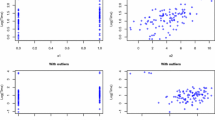Abstract
Clustered interval-censored failure time data often occur in a wide variety of research and application fields such as cancer and AIDS studies. For such data, the failure times of interest are interval-censored and may be correlated for subjects coming from the same cluster. This paper presents a robust semiparametric transformation mixed effect models to analyze such data and use a U-statistic based on rank correlation to estimate the unknown parameters. The large sample properties of the estimator are also established. In addition, the authors illustrate the performance of the proposed estimate with extensive simulations and two real data examples.
Similar content being viewed by others
References
Williamson J M, Kim H Y, Manatunga A, et al., Modeling survival data with informative cluster size, Statistics in Medicine, 2008, 27: 543–555.
Zhang X Y and Sun J, Regression analysis of clustered interval-censored failure time data with informative cluster size, Computational Statistics and Data Analysis, 2010, 54: 1817–1823.
Zhao H, Ma C C, Li J L, et al., Regression analysis of clustered interval-censored failure time data with linear transformation models in the presence of informative cluster size, Journal of Nonparametric Statistics, 2018, 30: 703–715.
Kang F Y, Sun L Q, and Cheng X M, An additive hazards model for clustered recurrent gap times, Journal of Systems Science and Complexity, 2018, 31(5): 1377–1390.
Bellamy S L, Li Y, Ryan L M, et al., Analysis of clustered and interval censored data from a community-based study in asthma, Statistics in Medicine, 2004, 23: 3607–3621.
Lam K F, Xu Y, and Cheung T L, A multiple imputation approach for clustered interval-censored survival data, Statistics in Medicine, 2010, 29: 680–693.
Li J L, Wang C J, and Sun J, Regression analysis of clustered interval-censored failure time data with the additive hazards model, Journal of Nonparametric Statistics, 2012, 24: 1041–1050.
Zhang X Y and Sun J, Semiparametric regression analysis of clustered interval-censored failure time data with informative cluster size, The International Journal of Biostatistics, 2013, 9: 205–214.
Pan C, Cai B, and Wang L M, Multiple frailty model for clustered interval-censored data with frailty selection, Statistical Methods in Medical Research, 2015, 1: 1–15.
Lin Y Y, Luo Y, Xie S Y, et al., Robust rank estimation for transformation models with random effects, Biometrika, 2017, 104: 971–986.
Han A K, Non-parametric analysis of a generalized regression model: The maximum rank correlation estimator, Journal of Econometrics, 1987, 35: 303–316.
Khan S and Tamer E, Partial rank estimation of duration models with general forms of censoring, Journal of Econometrics, 2007, 136: 251–280.
Sun J, The Statistical Analysis of Interval-Censored Failure Time Data, Springer, New York, 2006.
Nolan D and Pollard D, U-processes: Rates of convergence, The Annals of Statistics, 1987, 15: 780–799.
Pakes A and Pollard D, Simulation and the asymptotics of optimization estimators, Econometrica, 1989, 57: 1027–1057.
Jin Z, Ying Z, and Wei L J, A simple resampling method by perturbing the minimand, Biometrika, 2001, 88: 381–390.
Zhao H, Wu Q W, Li G, et al., Simultaneous estimation and variable selection for interval-censored data with broken adaptive ridge regression, Journal of the American Statistical Association, 2019, 1: 1–13.
Amemiya T, Advanced Econometrics, Harvard University Press, Cambridge, MA, 1985.
Sherman R, Maximal inequalities for degenerate U-processes with applications to optimization estimators, The Annals of Statistics, 1994, 22: 439–459.
Sherman R, The limiting distribution of the maximum rank correlation estimator, Econometrica, 1993, 61: 123–137.
Author information
Authors and Affiliations
Corresponding author
Additional information
This paper was supported by the National Natural Science Foundation of China under Grant Nos. 11471135 and 11861030.
This paper was recommended for publication by Editor LI Qizhai.
Rights and permissions
About this article
Cite this article
Luo, L., Zhao, H. Robust Regression Analysis for Clustered Interval-Censored Failure Time Data. J Syst Sci Complex 34, 1156–1174 (2021). https://doi.org/10.1007/s11424-020-9350-2
Received:
Revised:
Published:
Issue Date:
DOI: https://doi.org/10.1007/s11424-020-9350-2




